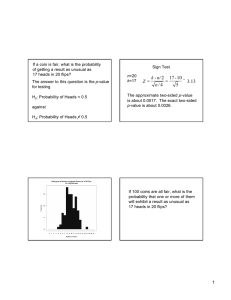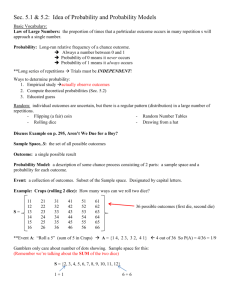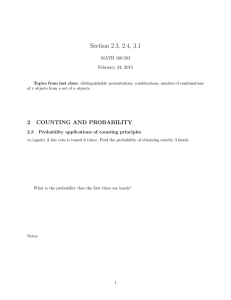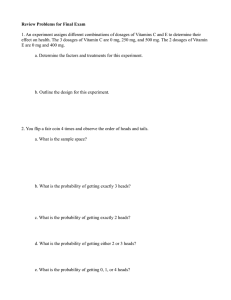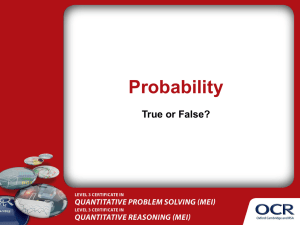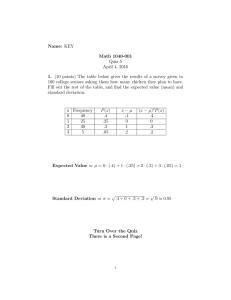Section 3.1, Basic Concepts of Probability and Counting
advertisement
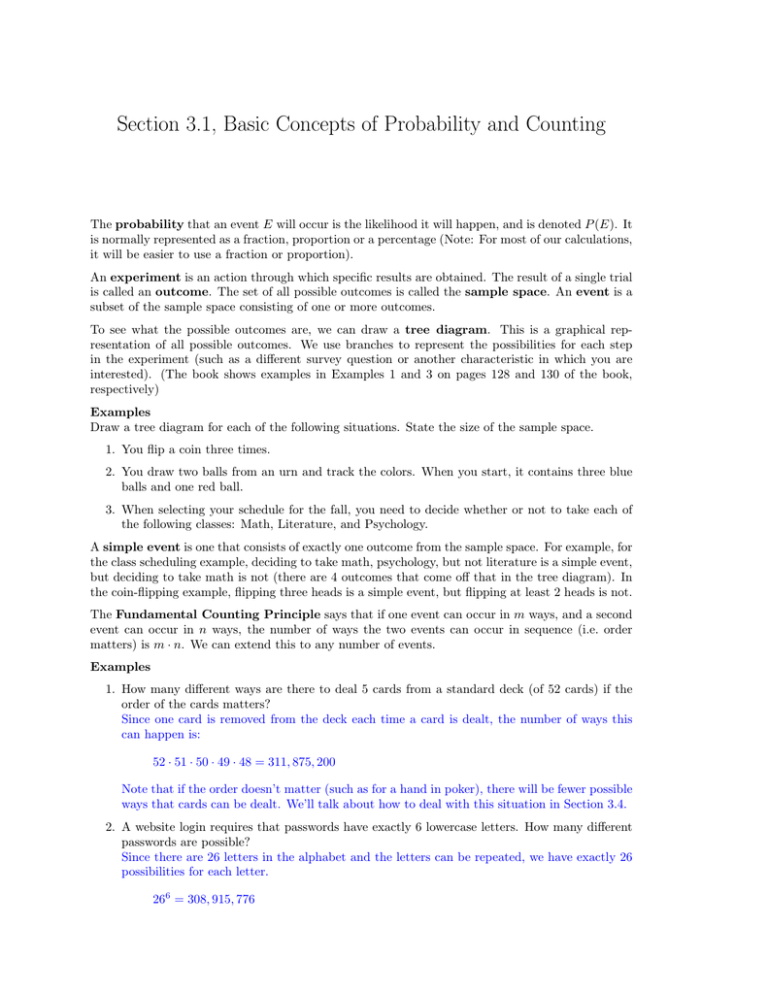
Section 3.1, Basic Concepts of Probability and Counting The probability that an event E will occur is the likelihood it will happen, and is denoted P (E). It is normally represented as a fraction, proportion or a percentage (Note: For most of our calculations, it will be easier to use a fraction or proportion). An experiment is an action through which specific results are obtained. The result of a single trial is called an outcome. The set of all possible outcomes is called the sample space. An event is a subset of the sample space consisting of one or more outcomes. To see what the possible outcomes are, we can draw a tree diagram. This is a graphical representation of all possible outcomes. We use branches to represent the possibilities for each step in the experiment (such as a different survey question or another characteristic in which you are interested). (The book shows examples in Examples 1 and 3 on pages 128 and 130 of the book, respectively) Examples Draw a tree diagram for each of the following situations. State the size of the sample space. 1. You flip a coin three times. 2. You draw two balls from an urn and track the colors. When you start, it contains three blue balls and one red ball. 3. When selecting your schedule for the fall, you need to decide whether or not to take each of the following classes: Math, Literature, and Psychology. A simple event is one that consists of exactly one outcome from the sample space. For example, for the class scheduling example, deciding to take math, psychology, but not literature is a simple event, but deciding to take math is not (there are 4 outcomes that come off that in the tree diagram). In the coin-flipping example, flipping three heads is a simple event, but flipping at least 2 heads is not. The Fundamental Counting Principle says that if one event can occur in m ways, and a second event can occur in n ways, the number of ways the two events can occur in sequence (i.e. order matters) is m · n. We can extend this to any number of events. Examples 1. How many different ways are there to deal 5 cards from a standard deck (of 52 cards) if the order of the cards matters? Since one card is removed from the deck each time a card is dealt, the number of ways this can happen is: 52 · 51 · 50 · 49 · 48 = 311, 875, 200 Note that if the order doesn’t matter (such as for a hand in poker), there will be fewer possible ways that cards can be dealt. We’ll talk about how to deal with this situation in Section 3.4. 2. A website login requires that passwords have exactly 6 lowercase letters. How many different passwords are possible? Since there are 26 letters in the alphabet and the letters can be repeated, we have exactly 26 possibilities for each letter. 266 = 308, 915, 776 If each outcome is equally likely to occur, then the probability of an event E is P (E) = Number of outcomes in E Total number of outcomes Translating this to data from a study, the probability of an event E is its relative probability: P (E) = Frequency of event E f = Total frequency n Examples 1. You flip a fair coin 3 times. What is the probability that you flip at least 2 heads? What is the probability that you flip all heads? From our tree diagram, we saw that there were 8 total outcomes, 4 of which contained at least 2 heads, so if E is the event that we flip at least 2 heads, so P (E) = 4/8 = 1/2. There was only one outcome that involved flipping all heads, so if E represents flipping all heads, P (E) = 1/8. 2. When drawing a card from a standard deck of cards, what is the probability that it is a diamond? What is the probability that it is between 5 and 10 (inclusive)? There are 13 diamonds in a deck of 52, so P = 13/52 = 1/4. There are 24 cards (6 from each suit) that are between 5 and 10, so P = 24/52 = 6/13. 3. After surveying 2000 people, you found that 1250 of them were in favor of a certain proposition, 500 were against it, and 250 were undecided. What is the probability that the next person you survey will be in favor of the proposition? Here, we are using data instead of “theoretical” knowledge. The probability of being in favor of the proposition is 1250/2000 = .625, so the probability that the next person surveyed will be in favor of the proposition is 0.625. 4. What is the probability that you guess a 6-character password on your first try (as we described earlier)? There were 308,915,776 possible passwords, so the probability that your one guess is correct is 1/308915776. The law of large numbers (LLN) says that as the sample size increases, the probability of an event occurring based on data approaches the actual probability of the event. The Range of Probabilities Rule says that 0 ≤ P (E) ≤ 1 for all events E. If the probability is zero, the event is impossible. If the probability is one, it always happens. The complement of an event E is the set of outcomes in the sample space that are not in E. It is denoted E 0 (“E prime”). Also, P (E) + P (E 0 ) = 1. Examples 1. You flip a fair coin 3 times. What is the complement of flipping at least 2 heads? What is the probability of this event? What is the complement of flipping all heads? If you don’t flip at least 2 heads, this means that you flipped either 0 or 1 heads, so the complement is the event that you flip at most 1 head (or that you flipped at least 2 tails). The probability of this is 1 − 1/2 = 1/2 (we had calculated the probability of flipping at least 2 heads earlier). The complement of flipping all heads is flipping at most 2 heads (or flipping at least one tail). 2. The probability that an employee is at least 40 is 0.426 at a certain company. What is the probability that an employee is under 40? Being under 40 is the complement of being at least 40, so the probability we want is 1−0.426 = 0.574.

